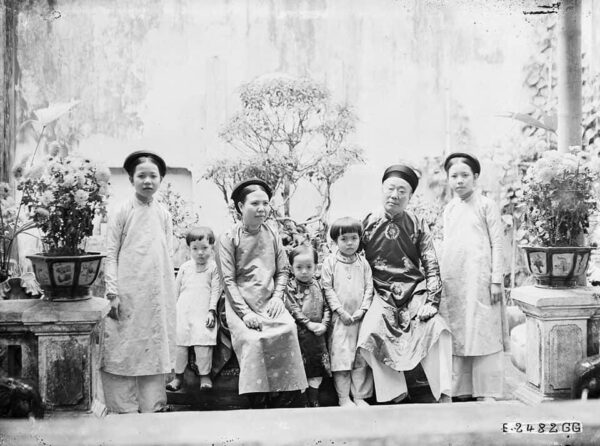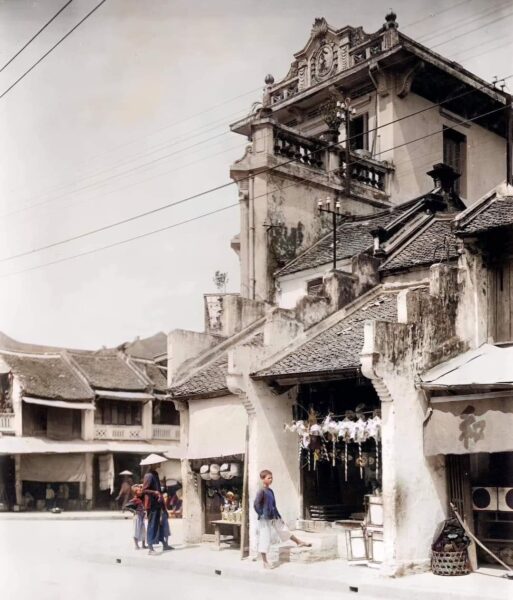In his work “Old Traditions – Vietnamese People,” writer Toan Anh affirms, “If a family is a small tree, then a lineage is an entire forest. The forest provides shelter for the tree, and even though the tree may be small, it contributes to making the forest denser. To understand the forest, you must start from the tree. To comprehend Vietnamese customs, one must begin with familial traditions.”
Editor’s Note: Hanoi’s familial traditions, with their distinctive features, to some extent, reflect the depth of the capital’s culture and history. They are an indispensable element in shaping the unique character of Hanoians. Over time, these old familial traditions persist in stories, and memories, and, notably, are passed down through generations of Hanoi families. However, the development of modern social life has brought about changes in the lifestyles of contemporary Hanoians. Therefore, preserving these “old traditions” in harmony with the new pace of life is essential, contributing to building elegant and civilized Hanoians. This is also the subject that the Nguoi Ha Noi magazine has chosen to address and explore in a series of articles on “Hanoi’s Familial Traditions.”

A corner exhibiting “Old Traditions” at the Hanoi Museum.
According to the Han-Viet Dictionary by Dao Duy Anh, “gia phong” is defined as “family customs: habits and education within the family.” Speaking of familial traditions is synonymous with speaking of “gia phong.” In the book “Cultural Customs ABC” by Pham Con Son, when discussing “gia phong,” it is mentioned, “Not only cultured and socially prestigious families know how to preserve familial traditions. Even poor families, less educated, who adhere to the rules of the village, live modestly, remind their offspring to study and work, observe rituals and morals according to oral advice, are families with ‘gia phong.’”
For generations, traditional Vietnamese families, including those in Hanoi, have always valued the preservation of familial traditions. Within these families, the people of Thang Long – Hanoi uphold “filial piety” to their grandparents and parents, “gentleness” to their daughters-in-law and sons-in-law, and “success” to their descendants. Grandparents and parents serve as role models for the younger generations.

An image of a prosperous Hanoi family’s Tet celebration at the beginning of the 20th century. Archival photo.
The principle of “respect the older, give in to the younger” is vividly expressed in the dining rituals, seating arrangements around the dining table, the order of invitations before meals, the act of offering the best portions to guests, and the etiquette of serving others before oneself. Even the act of eating itself requires restraint, with deliberate and unhurried chewing and swallowing.
Writer To Hoai, in his work “Old Stories of Hanoi,” provides a detailed account of Hanoi’s dining customs: “In dining etiquette, every family emphasizes proper presentation and seating arrangements around the table. […] Inside the house, no one explicitly instructs others, but it seems that seating positions are prearranged, and everyone knows their place. Grandparents and parents sit at the top, siblings, and children in the middle, husbands and wives avoid sitting next to each other, and daughters-in-law and daughters often sit near the pot, ladling out rice for the entire family. When offering a bowl or plate to the older, the person serving uses both hands, and when picking up food, they avoid clashing chopsticks with others. Chopsticks from the top pass over those from the bottom. When everyone is at the table, the customary invitation to eat is extended. The eldest often humorously says: ‘Let’s all enjoy the meal.’ People take turns inviting the elderly to eat first – never inviting those of lower rank. After finishing the meal, placing the cleaned bowl and crossed chopsticks, one politely says: ‘I am done eating.’ before standing up.”
This is the dining custom; as for the dress code, Hanoians also instill in their descendants a high degree of politeness. When going out, it’s customary to wear the traditional ao dai, along with the appropriate head covering and elegant footwear. When guests arrive, hosts maintain a sense of decorum, displaying a well-groomed appearance before extending hospitality.

The scholar Nguyen Tuong Phuong’s family (father of the art critic Nguyen Hai Yen) at their residence at No. 21 Tran Hung Dao during the Tet holiday in 1950. Family archival photo.
When reminiscing about his childhood years in the villa on Gambetta Street, now Tran Hung Dao Street (Hanoi), the art critic Nguyen Hai Yen recalls the valuable lessons taught by his mother: “My mother was an exemplary woman in terms of ‘work, appearance, speech, and conduct.’ From a young age, she taught us with great care and meticulousness, from our manner of speaking to our eating habits and even our attire. I remember every time she left the house, even just to the alley’s entrance, she wore trousers underneath the ao dai. My mother’s attire was always neat, radiating the characteristic beauty of Hanoian women.”
In their eloquent language, Thang Long – Hanoi residents utilize words with finesse, sophistication, and subtlety. Their communication style involves humility, respect for others, and eloquence without arrogance – cultivating talent without boastfulness and broad knowledge without condescension.
Hanoian girls were taught by their parents to embody “work, appearance, speech, and conduct,” preserving an air of grace, gentleness, and meaning in every aspect – from their walk, smiles, and gaze to their choice of jewelry.

In every ancient Hanoi family, familial traditions are held in high regard. Archival photo
Writer Ngo Vinh Binh, in his reflective work “Hanoi through My Eyes,” beautifully sketches a Hanoi adorned with the elegance of bygone family traditions. Through heartfelt tales of his grandmother, uncle, and his aunt’s family at No. 2 Cong Duc Street nestled within the ancient quarter, he narrates: “My aunt, a simple primary school teacher, possessed an eloquence and graciousness rarely seen. Once, during a visit, my aunt poured water and extended her hands, inviting my mother: ‘Please, have some water… Thank you.’ She was always gentle and responded with polite acknowledgments. Her conversations with me were likewise filled with a clever touch. Her house on this street has stood for three generations, dating back to her grandfather’s time. According to her, she was raised with these customs from a young age and became accustomed to them. All of her siblings I met were no different; they all carried themselves with the same refinement…”
Depending on each family’s circumstances, be it affluent, middle-class, or struggling, these age-old traditions are preserved in different yet fitting ways. However, whether well-off or modest, a clear sense of respect and order is maintained.

In every traditional Hanoi family, familial customs are held in high regard. Archival photo.
According to historian Duong Trung Quoc, neighborly relations serve as the environment for each family to uphold its unique “familial traditions” based on respecting the differences in each household’s circumstances. He illustrates this with a story from Hanoi: “Back then, there was little envy and much tolerance, so within families, education always leaned towards goodness. When encountering poorer neighbors, the wealthier parents would instruct their children to be considerate to avoid creating discomfort for the neighbors. They would also emphasize the saying ‘keep it clean if you’re poor, keep it fragrant if you’re ragged’ to remind their children.”
The observance of ancestral death anniversaries and Tet celebrations is highly regarded not only for its religious beliefs and ancestor worship but also as an opportunity for family members to gather. It is a chance for younger generations to recognize the extensive community and the intricate familial relationships, fostering a sense of social connection.
Despite the vibrant urban life, the people of Thang Long – Hanoi have preserved the spiritual and community-oriented aspects of their lives, such as picking lucky buds in early spring, visiting pagodas for blessings, praying for national peace, burning incense for ancestor worship, conducting ceremonies for New Year’s Eve, mutual well-wishing during land-clearing for the new year, and seeking the blessing of literary saints at the Temple of Literature.
Enduring through the twists and turns of history, the familial traditions of Hanoi, encompassing dining etiquette, dressing norms, and an elegant demeanor, have evolved to some extent. Traditional family models like “three-generation family” and “four-generation family” are gradually being replaced by nuclear families. Conflicts and clashes between generations in behavior and lifestyles are on the rise. Filial piety and decorum are losing their significance. In many households, the cherished tradition of family gatherings during meals is slowly diminishing. This is not to mention the prevalence of domestic violence and the encroachment of social vices into families. All these issues pose challenges to preserving and promoting the values of Hanoi’s familial traditions./.
Bao Nguyen
According to NHN

